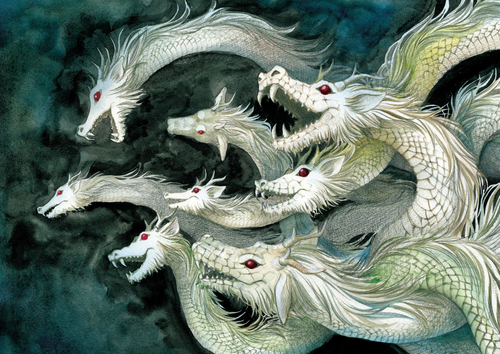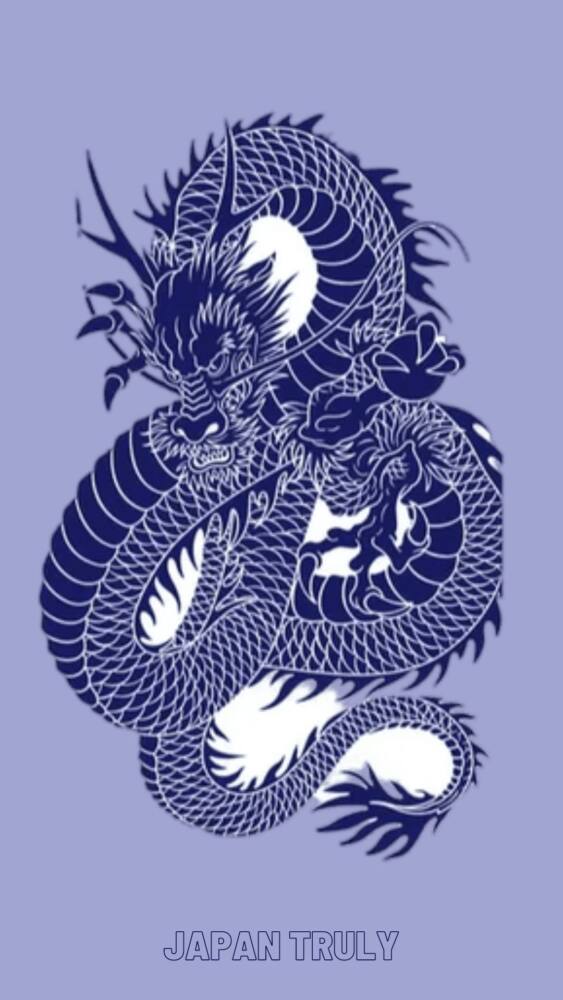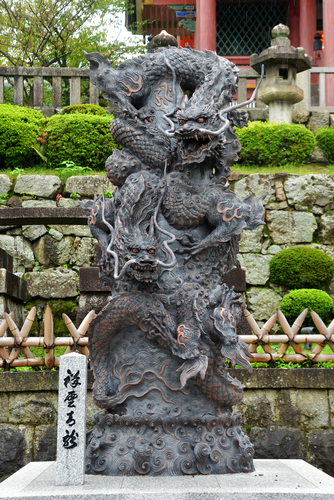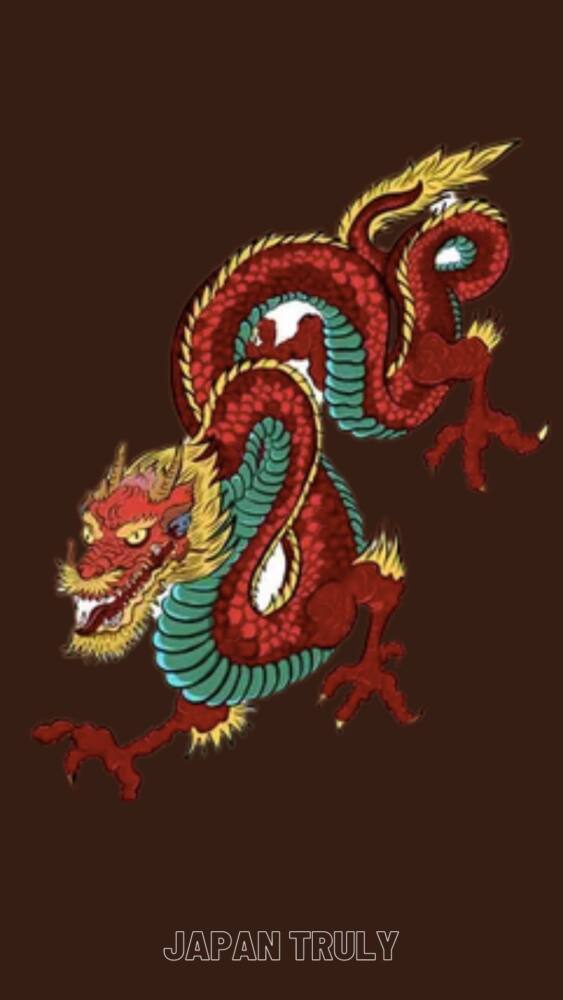Here’s all you need to know about 9 famous Japanese dragons names and meanings. Check out this list of Japanese dragons and their role in Japanese mythology.
In Japanese mythology, total creatures play a very prominent role but none as much as the powerful Dragons. Dragons are believed to be associated with water and they can shapeshift into a man.
Dragons, although not real, form a very crucial and important part of Japanese legends and tales. A very common misconception running around the world is that every Dragon is exactly the same throughout Asia. To some extent, this statement may be true but every country has its own kind of dragon.
- Related: List of Japanese Yokai
Japanese Dragons first made their appearances in Japanese mythology in the Kojiki (680 AD) and the Nihongi (720 AD).
The kojiki contains a collection of myths that is related to Japan's four home islands. The Nihongi has a more detailed and elaborate historical record as compared to the kojiki.
What is the most powerful Japanese dragon?
In Japanese mythology, there are several dragons that are considered powerful, but the most powerful one is probably the Ryūjin or the Dragon God. Ryūjin is the god of the sea and the ruler of all water-related elements.
He is often depicted as a dragon with a human-like face and is believed to have the power to control storms, waves, and tides. In Japanese folklore, Ryūjin is also associated with wealth and prosperity, and is often depicted holding a jewel or a treasure.
The Ryūjin is considered the most powerful Japanese dragon because of his control over the vast and unpredictable ocean, and his association with the forces of nature that shape the world.
List of Japanese Dragons
The common link between both these documents is that the water deities come in the shape of dragons. These creatures have been mentioned in several ways throughout the two historical documents. Here are some of the most popular Japanese dragon names:
Yamata no Orochi - The Eight-Headed Dragon
Orochi is a fearsome dragon with eight tails and eight heads. This is a legendary dragon where each head represents an element: fire, water, earth, wind, poison, thunder, light, and darkness.

As per the Legends, the dragon is set to devour one of the daughters of the two earthly Gods. The size of the dragon is extremely used and it has bloodshot eyes. As per the legends, his size is said to be equal to eight mountains and eight valleys. His body is covered with moss and cedar and it is always burning. Wherever he goes, he carries with him rivers of blood; he also carries with him a bell which has a very fearful sound that is feared by the locals.
The Legend
The Legend Begins with the story of Susanoo, the Shinto god of the sea and storms. He was expelled from the heavens because he tricked Amaterasu, his sister, and the Goddess of the Sun.
After being expelled, Susanoo reaches the Hi River where he meets the Kunitsukami (the two earthly gods), who he sees were crying because they have to give up one daughter every year for seven years in order to please Orochi. Susanoo learns that they now have to sacrifice their last daughter to Orochi.
Susanoo offers to help save the daughter from Orochi, but with a condition. In exchange for his offer to help her, he asked for the daughter's hand in marriage.
The earthly Gods agreed on this and Susanoo transformed their daughter into a comb. He then tucked her into his hair and told the Gods to prepare eightfold sake and make eight cupboards. Each of the cupboards was filled with tubs containing sake.
When the Orochi appeared to take the last daughter, Orochi noticed that the dragon had red eyes. He also noticed the dragon's tails and eight heads. His size was gigantic.
When the Orochi reached the house and he drank all of the sake, he became drunk and then fell asleep. Susanoo took a perfect chance and he slew the dragon by using his ten-span sword.
He chopped Orochi into small pieces. When he finally split the dragon's tail open, he found that there was a sword inside. This is the sword that Susanoo gave Amaterasu as a form of reconciliation.
This sword is known as Kusanagi-no-Tsurugi or The Sword of the Sky. This sword is one of the three sacred treasures of Japan.
Mizuchi - The Hornless Dragon
The Mizuchi Dragons are fearsome water Dragons with poisonous breath. The open ended up killing anybody who wanted to get close to them.

The Legend
As per the Legend, there was an ancestor of the clan of Kasa no omi, who was known by the name of Agatamori. He went to the river where the water dragon was said to dwell; he then challenged the dragon.
He cast three bottle gourds to the pool of the river and they remained afloat. The challenge was that Mizuchi had to make the bottle gourds sink or else Agatamori would slay him. The dragon accepted the challenge and he changed himself into a deer to try and sink the bottle gourds.
However, he was unsuccessful in winning the challenge and so Agatomori slew him. He also slew every other water dragon living at the bottom of the river. Because of the blood of all the dragons, the water turned red. This river was later known as the pool of Agatamori.
Watatsumi - The Sea God
Also known as Ryujin, Watatsumi was a legendary water God and Japanese Dragon. This legendary dragon is a very important part of Japanese mythology. In English, the dragon’s name translates to the great God of the sea.
This dragon is said to have a long snake-like body that is covered with scales. When depicted in mythology and legends, he is shown as having a long mustache and beard and three claws legs.
It is believed that Watatsumi lives at the bottom of the ocean known as Ryugo-jo. He lives in a huge palace that is made of corals. He has servants in the form of sea turtles, fish, and jellyfish.
He is also known to change his form into a human to visit the surface. Also, as per legends, it is believed that the dragon served as a guardian for the Shinto religion. He also welcomes humans into his palace if they ever fall into the sea. We can see him and his various daughters making several appearances in Japanese legends.
The Legend
There are several stories associated with Watatsumi. One of the stories is about a man named Hoori who lost his brother's fish hook in the sea. He was searching for it when he met Watatsumi's daughter, Otohime.
Upon meeting, Hoori and the daughter got married and started living in Ryugo-jo. They lived happily for three years after which he started feeling homesick. However, since he had lost his brother's fishhook, he was afraid to face him.
On seeing the concern on Hoori's face, Watatsumi confronted him and asked him what the problem was. When he learned about his problem, the water God summoned all of the fishes of the sea and asked them if any of them had seen the fish hook.
Fortunately, one of the fishes knew about the fish hook and told the sea god that the fish hook was stuck in its throat. The hook was obtained, washed, and finally given to Hoori.
When he found the hook, Watatsumi instructed Hoori to take his daughter back with him to the lands along with Wani, another mythical dragon who is known to be a sea monster.
Toyotama-hime - The Luminous Pearl Princess
Toyotama-hime is a descendant of Watatsumi. She is also known as the luxuriant Jewel Princess and she is a part of the Legend that is known as luck of the sea and luck of the mountain. This Japanese dragon's name is quite unique.
The Legend
In the Legend, Toyota Mahima is not shown to be the daughter of Otohime and Hoori, but instead, we can see that she is Otohime herself.
The story about Otohime and Hoori getting married and living happily in the sea for three years is still true in this legend. Later, Watatsumi recognizes that he is a descendant of another God and so he arranges a banquet for him.
In this Legend, we see the life of Otohime and Hoori on land. When Toyotama-hime got pregnant, Hoori built her a hut so she could deliver the child. The god asked Hoori not to witness the childbirth, but Hoori was very curious, and so he spied on his wife.
When he went to see his wife, instead of a woman he saw a crocodile-like Wani cradling the son. It is believed that it was important for Toyotama-hime to transform into a Wani for the birth-giving process. She did not want her husband to see her in that state.
When Toyotama-hime found Hoori spying on her, she felt betrayed. She could not forgive her husband for this and decided to leave him and their son by going back to the ocean. To raise her son, she sent her sister Tamayori to Hoori. Eventually, the Tamayori and Otohime’s son got married and they gave birth to a child.
Kiyohime - The Purity Princess
Kiyohime is also simply known as Kiyo. She was believed to be the daughter of a landlord known as Shoji. She belongs to a very wealthy family and was in charge of entertaining and providing lodging facilities to traveling priests. This is one of the different types of Japanese dragons.
The Legend
As per the legend of Kiyo, we find that a handsome priest called Anchin fell in love with her but eventually, he decided to fight through his urges and refrain from meeting her again. Kiyo could not take the sudden change in the priest and she went after him in rage.
Finally, at the Hidaka river, they both crossed paths. Anchin asked a boatman to help them cross the river. He also told the boatman not to allow Kiyo in the boat so that he could escape.
When Kiyo realized and understood Anchin’s plan of not letting her on board, she jumped into the river and started swimming towards his boat. She was in so much rage that she transformed into a large dragon.
To get help and protection, Anchin ran into a temple known as DoJo-Ji. The priests of the temple helped him hide under a bell. However, Kiyo used his scent to find him. She coiled herself around the bell and banged on it several times using her tail. Then she blew out a great amount of fire that ultimately melted the bell and killed Anchin.
The Azure Dragon - Protector of Kyoto
As per legends, it is believed that the Azure Dragon is the Protector of the city of Kyoto. It is believed that the dragon dwells in the Eastern part of the city. There are also several temples built in Kyoto to honor the Azure Dragon. The most well-known temple is the Kiyomizu Temple where a ceremony is held every year to worship the Azure Dragon.

Nure-onna - The Treacherous Woman Dragon
Nure-onna is believed to be a very few or some dragon with the head of a woman and the body of a giant snake. Different legends have a slightly varied description of the dragons’ appearance. But generally, the most common description is of a dragon with snake-like eyes and sharp claws and fangs.
Nure-onna is usually believed to haunt river sources where she can be seen washing her long hair. There are several legends as per which she also carries a small child in her arms. The child is a means to attract potential victims. When she gets a victim and if he tries to escape, the child attaches himself making it absolutely impossible to escape. There are also several stories in which it is believed that the Dragon uses her powerful tongue to suck all the blood out of the victims.
Wani - The Crocodile Dragon
Wani has been mentioned twice in Japanese legends as the sea monster or simple crocodile. The Wani dragon was first mentioned in the "White Hare of Inaba" fable and the second mention is in the myth of the demigod brothers Hoori and Hoderi. Wani is often translated as sharks in Japanese Kanji.
Seiryu - The Azure Dragon and 4 Dragons
The Seiryu dragon in Japan is known to protect the city of Kyoto on the east with 4 other dragons. The other dragons protect each direction of the city. You’ll find temples in Kyoto that are dedicated to the Azure dragons.
It’s often referred to as the blue dragon. Many believe that the Seiryu Japanese dragon is the cause of the havoc in the mankind world. The colour of the four creatures are red, blue, green and white. Seiryu dragons have been mentioned twice in the Japanese legends, once as protector of the city and other time as protector of the sea.
Japanese Dragons vs Chinese Dragons
There is a very common belief across the planet that all Dragons are the same. It is also believed that Chinese mythology has more Dragons as compared to Japanese mythology. This is somewhat understandable because a lot of Japanese cultures and traditions are influenced by Chinese beliefs.
However, it is completely wrong to say that Chinese Dragons and Japanese Dragons are the same because there are some differences between them.
When we talk about the body and appearance of Japanese Dragons, we see that they have three toes per foot. Chinese Dragons, on the other hand, have around four to five toes in each foot.
Japanese Dragons also have a very snake-like body and they have a slender physique. When we talk about the portrayal of dragons in legends, we see that Chinese Dragons have benevolent roles. Japanese Dragons, on the other hand, are considered to be malevolent beasts.
As per Chinese mythology, dragons are associated with water and they are considered to be bringers of rain for agriculture. In Japanese mythology, however, dragons are used in such scenarios that put more focus on heroic deities. The boundaries between Chinese Dragons and Japanese Dragons are not particularly fixed.
In many of the Chinese mythologies, we can see that the dragons have been portrayed in Japanese-like physique.
Japanese Dragons and Mythology
Japanese mythology and legends are extremely successful and they make use of Shinto, Buddhist, and folklore beliefs. As per Japanese mythology, when the universe was created it is believed that several deities came into existence. All of them were together referred to as kotoamatsukami.
When heaven and Earth were finally formed, it is believed by the Japanese that seven generations of Gods emerged and they were known as the Age of the Gods' seven generations. In Japanese, this is known as kamiyonanayo.

Kamiyonanayo is said to have 12 gods. From these 12 deities, it is believed that many other Gods and Goddesses finally came into emergence. However, they did not come alone. They had with them several creatures that served as their guardians, messengers, warriors, and enemies.
One of the creatures that came into existence were the unique Dragons. These Dragons are associated with water Gods who were known to have ruled the oceans. These Dragons fought with other Gods, shape-shifted into humans, or vice versa. Dragons are also known to be the signifier of wisdom, success, and strength.
Japanese Dragons and Art
The Japanese use Dragons for their art. Japanese Dragons are known to be symbols of strength, wisdom and prosperity, longevity and luck. The Japanese depict Dragons in tattoo designs drawing paintings or symbols. Some of the common dragon art and what they symbolize include:
- Ouroboros - the cycle of life
- A sleeping dragon - hidden power or strength
- A gothic dragon - fearlessness
- A tribal dragon - the culture of the tribe from where it originated
- A rising dragon - progress and ascension
- A yin-yang dragon - the proper balance of forces
- A dragon and snake - conflict between superstition and science
- A dragon and tiger - the importance of brains over brawn
- A dragon claw - power and fearlessness
- A dragon skull - conquering difficulties
- A dragon and moon - the connection between nature and sub-consciousness
- A flaming dragon - sexual desires, passion, and power
List of Japanese Dragons: FAQ
What are the Japanese dragons called?
Who is the Japanese god of dragons?
What's the difference between a Chinese and Japanese dragon?
The myths and the legends!
I hope you enjoyed knowing about the different kinds of Japanese dragons and the importance they have in Japanese myths and legends. These dragons are a very important part of Japanese symbolism and are used quite widely and commonly in tattoos, art paintings, and other symbols.
Also read:




